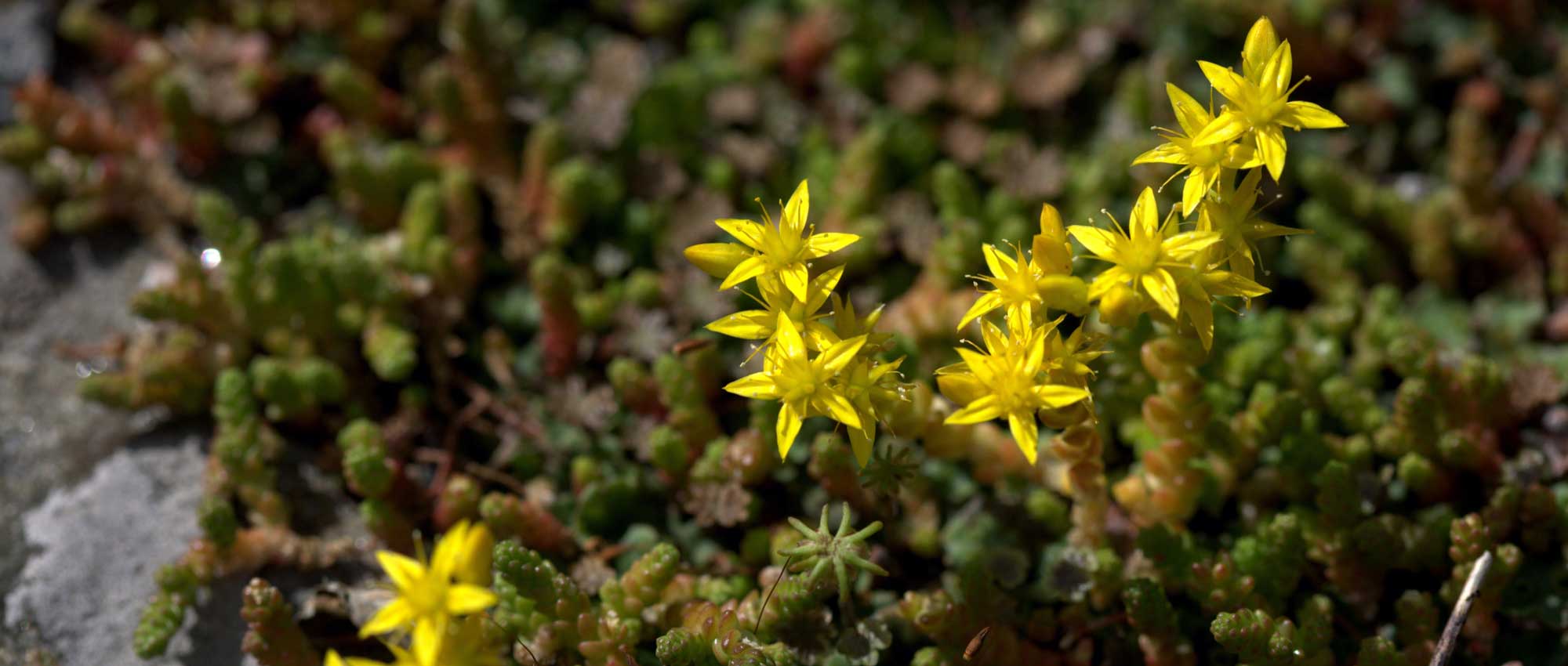
Sedum or orpin: which variety to choose?
depending on each situation
Contents
Sedums are succulent plants from the Crassulaceae family. They form a heterogeneous group, with very varied foliage, habit, and flowering. Their flowers can be white, pink, or yellow, the leaves can be flat and developed or small and imbricate, and they can take on many different shades. With over 400 species and multiple horticultural varieties, the choice is vast! To make it easier to navigate, sedums can be separated into two main categories: the small, ground-hugging types (15-20 cm in height), often evergreen, and the tall, upright types (about 50 cm), generally deciduous.
To choose a sedum, one must first determine its intended use: Is it for creating a rockery, making a composition in a container, greening a roof, planting on a wall, landscaping a bed, or even growing indoors? In all these cases, it is essential to choose the driest and sunniest location possible.
At the edge or in a bed, a tall, upright sedum, such as Sedum spectabile, will add volume to the overall arrangement. Conversely, in a rockery, on a wall, or a green roof, a small, ground-hugging sedum is preferred. For composing container arrangements, both can be used to play with heights. Diversity is then prioritised, both in shapes and colours. Discover all our tips for choosing the right variety of sedum!
For a rockery, a low wall, or a green roof: creeping sedums
The lowest varieties are perfect for enhancing a rockery, a low wall, or a green roof. They are suitable for use as ground cover. Most of them measure 10 to 15 cm in height. Their foliage is evergreen and takes on very varied shades! When these sedums flower, they bear a multitude of small flowers, often yellow, pink, or white. The soil then appears covered with a colourful and flowering tapetum.
Their spreading habit, extreme resistance to heat and drought, as well as their shallow rooting, allow them to be used to green areas of the garden where other plants do not thrive (they can even replace grass!). With their evergreen foliage, they will bring green and colour even in the middle of winter. Enjoy!
Their foliage can be purple (Sedum spathulifolium ‘Purpureum’), yellow-green (Sedum reflexum ‘Angelina’), variegated edged with cream white (Sedum kamtschaticum ‘Variegatum’) or even silver (Sedum spathulifolium ‘Cape blanco’). We recommend Sedum reflexum ‘Angelina’: its remarkable lemon colour, very soft, will bring a lot of brightness if placed among darker foliage. As for the silver foliage of Sedum spathulifolium ‘Cape blanco’, install it with other plants in similar tones, such as Santolines.
If you wish to replace grass or cover a spot where nothing grows, consider Sedum acre: it spreads easily, is very low, and in summer boasts a lovely yellow flowering. Sedum spurium may also be suitable: it will bring a bit more colour, as its foliage takes on red hues.
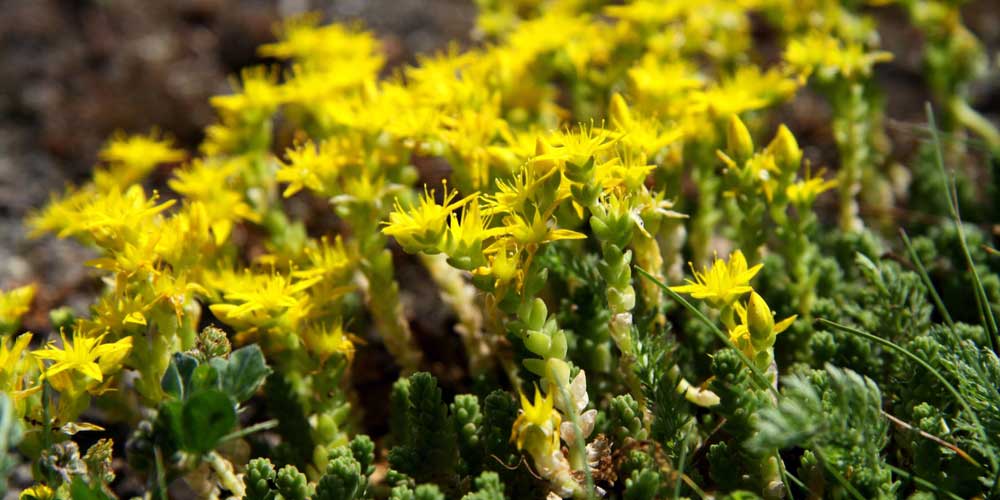
Sedum acre is a small spreading stonecrop with bright flowering (photo Chmee2)
In beds or borders: tall and upright sedums
To create a border or a flower bed, we recommend choosing tall and upright sedums. They are interesting for their late summer flowering, which attracts many butterflies and adds volume to the beds. They can grow up to 70 cm tall, such as Sedum spectabile ‘Carmen’. Their leaves are flat and broad, sometimes deciduous.
Most of them offer pink flowering. Our favourite variety is Sedum ‘Herbstfreude’: it features both bluish-green foliage and beautiful mauve-pink flowers, which change colour as they bloom, turning bronze in autumn. If you prefer paler flowers, consider Sedum spectabile ‘Stardust’ with white flowers, or Sedum ‘Eline’ with cream-yellow flowers.
The leaves of these sedums are often green, but they can also be purple, as seen in the varieties ‘Matrona’, ‘Orange Xenox’, or ‘Jose Aubergine’. These dark foliage types pair well with plants that have red or orange flowers, such as Crocosmias. Feel free to combine them with lighter-toned plants: plant 3 to 5 clumps of Sedum ‘Matrona’ behind a tapetum of Sedum reflexum ‘Angelina’ for a contrast that plays with light.
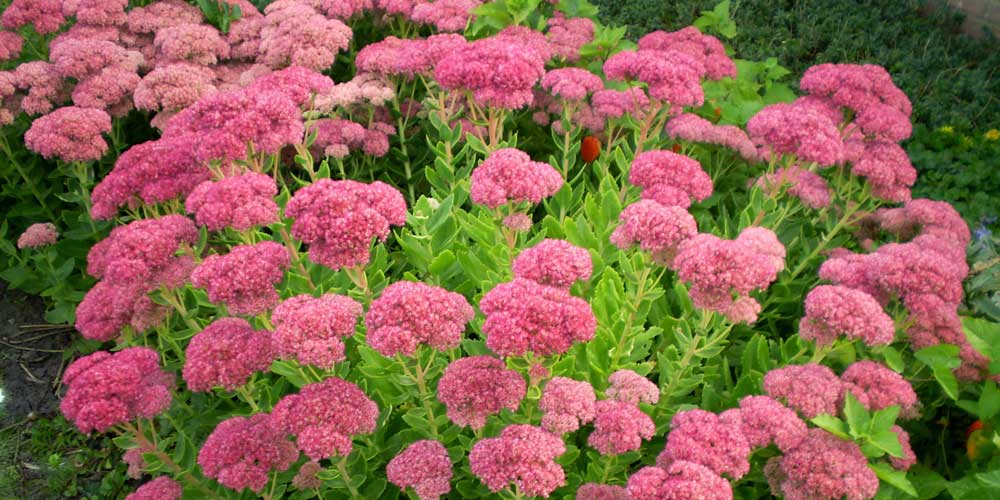
Sedum spectabile ‘Brilliant’
Discover other Sedum
View all →Available in 0 sizes
Available in 1 sizes
Available in 1 sizes
Available in 2 sizes
Available in 3 sizes
Available in 0 sizes
Available in 2 sizes
Available in 0 sizes
Available in 1 sizes
Available in 1 sizes
Some possible uses
- Do you want to green up an old stone wall?
You can slip plants into the crevices of a stone wall. For example, place Sedum album alongside some campanulas (Campanula muralis), Erigeron karvinskianus, saxifrages, and houseleeks. The Sedum acre, Sedum spurium, or Sedum pachyclados are also very suitable for this use! Avoid larger varieties like Sedum spectabile.
 Sedum reflexum ‘Angelina’, Sedum album (photo Stefan.lefnaer) and Sedum pachyclados[/caption>
Sedum reflexum ‘Angelina’, Sedum album (photo Stefan.lefnaer) and Sedum pachyclados[/caption>
-
- Do you want to plant a sedum in a rock garden?
Sedum can be part of dry rock gardens, exposed to full sun. Plant Sedum kamtschaticum or Sedum reflexum alongside rock or alpine plants, such as saxifrages, gentians, houseleeks, cerastiums, or aubrietes.

Sedum kamtschaticum ‘Variegatum'[/caption>
-
- Are you planning to green a roof?
Sedum is particularly suitable for green roofs, as it can withstand very high as well as very low temperatures (important hardiness), wind, and drought. It requires little maintenance, no watering, and its shallow roots allow it to be grown on a very thin layer of substrate.
Create a “splash of colour” effect by choosing various varieties with colourful foliage, which you will plant in groups of at least 5 to 7 plants each time: Sedum spurium, Sedum acre ‘Yellow Queen’, Sedum album, or Sedum reflexum.
[caption id="attachment_35371" align="alignnone" width="1000"] A green roof (photo Lamiot) / Sedum album (photo Meneerke bloem)
A green roof (photo Lamiot) / Sedum album (photo Meneerke bloem)
- Do you want to design a Mediterranean, dry, low-maintenance garden?
Plant sedums in a dry, very mineral garden, alongside lavender, euphorbias, and Helichrysum. Scatter some grasses to create a very Mediterranean landscape. For example, you can place a few plants of Sedum spectabile next to Stipa tenuifolia and Senecio cineraria.
[caption id="attachment_35383" align="alignright" width="1000"] Sedum spectabile ‘Septemberglut’ / Stipa tenuifolia / Senecio cineraria
Sedum spectabile ‘Septemberglut’ / Stipa tenuifolia / Senecio cineraria
- Do you want to grow sedum in a bowl?
Mix upright varieties with low varieties, and blend the colours: for example, Sedum reflexum ‘Angelina’ with Sedum ‘Matrona’, and Sedum reflexum ‘Blue Spruce’! Add some rosette sedums (Sedum palmeri), houseleeks (Sempervivum), and Echeverias. You can place some decorative stones to create a small rock garden effect. Then place the pot on a terrace, on the edge of an outdoor staircase, or on a wall.

You can create bowl compositions by combining Echeverias and sedums, including Sedum palmeri (in the centre, photo Wolfgang Sauber)
- Do you want to integrate sedum into a flower bed?
Choose tall varieties, such as Sedum ‘Herbstfreude’, or Sedum ‘Matrona’ – a variety with purple foliage – which you will plant in groups of 5 to 7 plants. You can place some creeping sedums, like Sedum kamtschaticum, with its beautiful bright yellow flowers that will stand out among the darker foliage, in front of them. Position some tufts of grasses on either side (Pennisetum or Stipa). They will add lightness and create a nice contrast against the more massive foliage and habit of the sedums.

Sedum ‘Herbstfreude’
- Do you want a colourful mix throughout the year?
Mix varieties with colourful foliage, choosing evergreen species. Select 4 to 5 varieties in different shades, or more, which you will plant in groups of at least 5 plants, to create a beautiful splash of colour effect. You can thus plant Sedum reflexum ‘Angelina’ alongside Sedum hakonense ‘Chocolate Ball’, Sedum spathulifolium ‘Purpureum’, and Sedum reflexum ‘Blue Spruce’. If you live in the Mediterranean region, add Sedum rubrotinctum for its lovely red hues in winter.

Sedum ‘Chocolate Ball’ / Sedum rubrotinctum (photo Shine B) / Sedum reflexum (photo Liné1)
Varieties with unique foliage
To enjoy the full diversity of sedums, you can also opt for the following species and varieties with original foliage:
- Rosette: Sedum pachyclados and Sedum palmeri (magnificent varieties with an exotic appearance!)
- Chocolate colour: Sedum hakonense ‘Chocolate Ball’
- Bicolour: Sedum kamtschaticum ‘Variegatum’ (green leaves edged with cream white)
- Tricolour: Sedum spurium ‘Tricolor’
- Silver: Sedum spathulifolium ‘Cape blanco’
- Almost black: Sedum ussuriense ‘Turkish Delight’
- Cristate: Sedum reflexum ‘Cristatum’
- Subscribe!
- Contents

































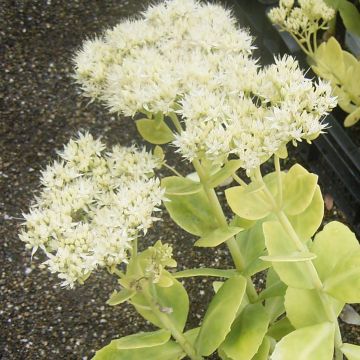
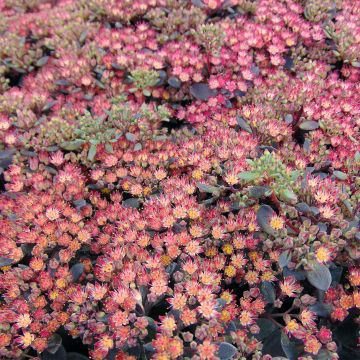
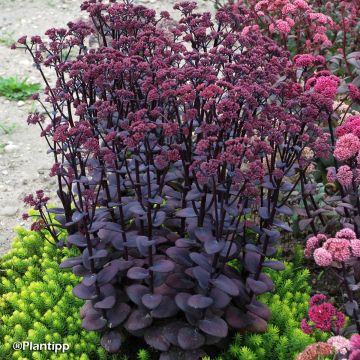
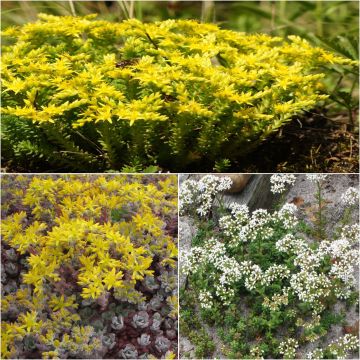
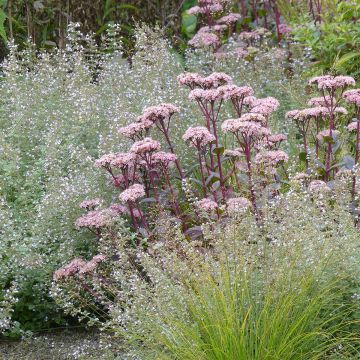
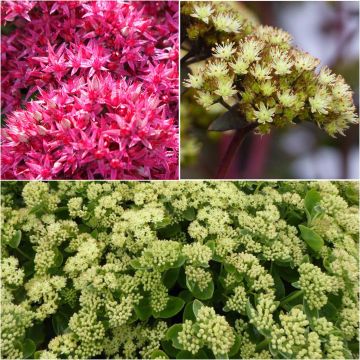
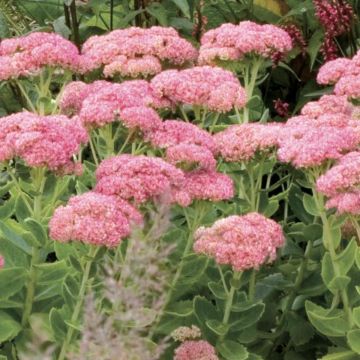
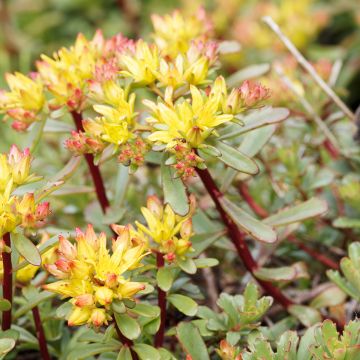
Comments